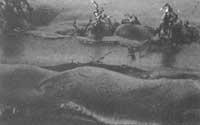Air of Kuwait
The conclusions drawn from studies conducted in the capital of Kuwait indicate that the air of the city is not much more polluted than that of Paris. But the most worrying thing about this air are the components, which can be carcinogenic.
The air of the capital is black and full of gedares. Although sometimes you can see rays of sun when the wind moves the clouds, you can say that there is a continuous night. Remember that the cause is the 180 burning northern oil wells and the 350 south.
The measured data has been surprising. No carbon oxides have been found and very few nitrogen and ozone oxides have been found. The maximum amount of sulfur dioxide has been 3,000 m/m 3. Please note that the limit set by the World Health Organization (WHO) in working conditions is 5,000 m/m 3 in 8 hours a day and 5 days a week.

According to the researchers, the reason for not finding classic contaminants lies in the combustion temperature of oil, which does not exceed 700°C-800°C. In addition, the variability of the oil fires has prevented the intake of the composition of the standard smoke. While some wells have a low fire, some kisses have a height of 100 m.
The real problem lies in the influence of particles and powders, whose quantity is 2,000 m/m 3. For example, the amount measured in Paris is 40 m/m 3. Thicker gedar particles do not cause major damage, as they are retained by the hairs of the nose. Therefore, they do not reach the lungs and produce maximum pharyngeal irritation or cough. However, there are particles smaller than the average micron that can reach the lungs. In addition, some particles act as pollutant catalysts generating OS 4 and OS 4 H 2. These can be mixed with unburned hydrocarbons, i.e. carcinogenic compounds.
Although we have talked about the problem in Kuwait, we also have to provide data on the black rains in Iran, because the origin of these two problems is the same.
Last April, water and soil samples collected in Khouzistan province in Iran were analyzed in Geneva. The water was black rain and full of gedares. It had lead, sulphates and a lot of organic matter. Therefore, water was not suitable for human consumption.
Earth analysis gave similar results. The gedar ratio was 10%. This gedar contained lead, cadmium and aromatic hydrocarbons.
According to the WHO, immediate health problems are not expected, but if the accumulation of heavy metals increases in the future, serious problems will occur.
Buletina
Bidali zure helbide elektronikoa eta jaso asteroko buletina zure sarrera-ontzian











